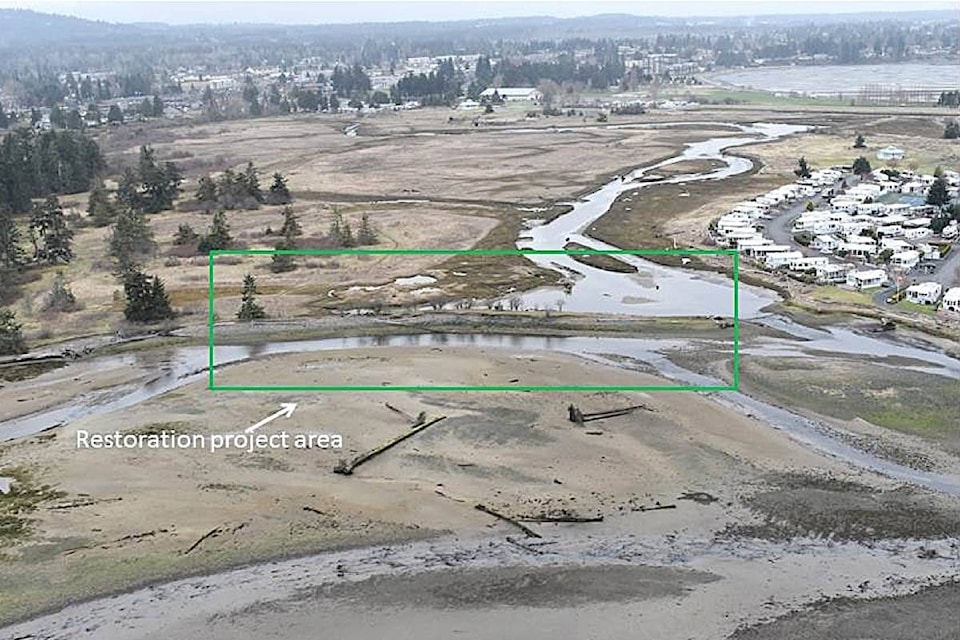Hikers accustomed to a peaceful, quite stroll on the trails of the Englishman River Estuary will be faced with some unaccustomed construction traffic in the coming weeks. But it’s all meant to enhance the estuary in the long run.
The first phase of a five-year estuary enhancement restoration project will begin in late July, with the ultimate goal of restoring natural tidal and river flows and making the area more accessible to fish and wildlife, said Tom Reid, project manager for the Vancouver Island Conservation Land Management Program (VICMLP).
“We want to make sure the public is aware when there’s massive excavation equipment out there,” said Reid. “The machines will be accessing the worksite through the end of Shelly Road. We expect equipment to start showing up near the end of July. Between July 28 and August 10 most of the activity will happen with the large equipment.”
VICLMP is undertaking the project on behalf of The Nature Trust of B.C., with a host of partner organizations involved, including the local Mid-Vancouver Island Habitat Enhancement Society (MVIHES) and Arrowsmith Naturalists.
This phase of work will involve removing a man-made berm, installed decades ago, that separates the saltwater estuary from a grassy marshland to the west.
“What they’re hoping is that when the berm is removed it will allow a lot more natural intrusion of seawater into that area and restore it as a tidal marsh,” said Dave Hutchings of the Arrowsmith Naturalists. “They’re hoping to allow the estuary to basically move back into the areas which has been blocked for a number of years.”
The Arrowsmith Naturalists have been asked to undertake bird and vegetation surveys in that isolated marsh. The MVIHES, meanwhile, has begun some seining in the area’s waters, and will survey current fish and invertebrate life in the grassy marsh.
The surveys, Hutchings said, are to establish a baseline of the species currently in the area cut off from the estuary.
“We’ll come back next year to survey again, and they’ll see how life changes on the estuary in succeeding years,” he said.
Funding for the project is provided by Canada’s National Wetland Conservation Fund and the Habitat Conservation Trust Foundation. Asked the cost of the project, Reid said proposals are still being sought by the Wetland Conservation Fund, but the total is expected to be “in the range of $150,000 to $200,000.”
Additional help will come from in-kind contributions from local stewardship organizations, he added.
Low-impact work has already begun with divers and fisheries biologists surveying the site, said Reid.
The first step of the five-year restoration project is to remove a man-made berm on the west side of the estuary that was originally constructed in the 1960s for log booming operations. Other activities this summer will include enhancing tidal channels; increasing habitat complexity for fish and wildlife; and removing invasive plants.
“That whole area of the estuary has been used and abused for generations,” said Hutchings, who added the berm was originally placed, essentially, as a dike to facilitate farming on the land to the west. “At one point it was a log-sort area, and the wooded area was proposed as a campsite in the late ’70s or early ’80s.”
That campsite proposal prompted a public backlash that eventually brought in the Nature Trust, which purchased the land, said Hutchings.
The entire estuary as since been included in a Wildlife Management Area that extends along the coast from the Englishman River to the Little Qualicum River to the north.
During construction, trail access will be prohibited within the work zone for safety reasons, said Reid. But the rest of the trail system will remain open to the public.
“There will be signs and marked detours so people can still hike the trails,” said Reid. “And we’ll have people on-site to make sure the public is safe. There will be lots of opportunity for the public to ask questions.”
Hikers may even get to view some of the work in progress from the viewing platform in the estuary, near the end of the central trail.
The Englishman River estuary and adjacent habitats support more than 250 bird species, 23 mammals, plus several amphibians, reptiles, all species of Pacific salmon, and forage fish such as herring and Pacific sand lance, The Nature Trust of B.C. said in a news release. Currently, more than 100 hectares (247 acres) of the Englishman estuary and adjacent forest are protected and form part of the Parksville-Qualicum Beach Wildlife Management Area.
“The Nature Trust of B.C. has been working with partners for decades to acquire and manage ecologically important lands along the Englishman River,” said Jasper Lament, CEO of The Nature Trust of B.C. “It is a key river for fish and wildlife, and this habitat restoration project will have an enormous benefit for the future.”
Since the 1930s, the Englishman estuary has been impacted by dikes, roads, residential development, industrial uses, and ditching. Today portions of the estuary are almost completely cut off from natural tidal and river processes. Consequently, the estuary has become less accessible for fish and wildlife that would normally use these habitats for shelter, feeding, and rearing.
Project partners include Fisheries and Oceans Canada, Ministry of Forests, Lands and Natural Resource Operations, the B.C. Conservation Foundation, Mid-Vancouver Island Habitat Enhancement Society, the Arrowsmith Naturalists, and Guardians of Mid-Island Estuaries Society.
